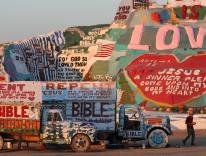
My wife and I have often vacationed in Vermont. Back in the Bronze Age, we even honeymooned in the Green Mountain state. On our last few visits we have stayed in a fancy hotel in Manchester, which is in Southern Vermont near the New York border. It’s about a four-hour drive from our home, which makes it not too far but far enough to get the sense of being “away.”
Manchester became a popular resort in the nineteenth century, and it has an impressive stock of large nineteenth and early-twentieth-century homes. Now it also boasts factory outlets, lots of restaurants, and the terrific Northshire Bookstore. Once we were there the week before Halloween, and were surprised and delighted to witness a parade of elaborately costumed elementary-school students and their teachers marching down the main street.
Among Manchester’s more notable residents was Robert Todd Lincoln, the only child of Abraham Lincoln to survive to adulthood. Robert, a corporate lawyer, eventually became president of the Pullman Palace Car Company, then the largest manufacturing firm in America. He built Hildene, an extravagant Georgian revival mansion, on a 412-acre estate just outside of town. Hildene is now a museum open to the public, its furnishings and rooms preserved more or less as they were when the house was finished in 1905. One of Abraham Lincoln’s totemic stovepipe hats is on display in a room dedicated to the martyred president. The views from Hildene, which is situated on a ridge between the Green Mountains and New York’s Taconic Range, are spectacular. In one sense, the house is a monument of sorts to the excesses of the Gilded Age. But it is also a symbol of American possibilities. For a family to go from a log cabin to a domestic basilica in just two generations seems the very definition of the American Dream.
I haven’t traveled much and have never lived abroad. This little soliloquy on Manchester is a roundabout way of introducing the topic of travel writing. The library/game room at our Manchester hotel was well stocked with lavish and expensive books on photography and art. I spent a good hour there perusing Condé Nast Traveler Photographs: Twenty-fifth Anniversary Collection. I have never read Condé Nast Traveler, which is marketed to readers with much larger travel ambitions and budgets than my own. But I must confess that the photography in the Anniversary Collection took my breath away. Luckily, my wife found a used copy online and gave it to me as a birthday present. Poring over my own copy is one way to “travel” while being locked down. It is an oversized book with stunning full-page photos of locations both exotic and familiar. There are swimmers seemingly posed to go over Victoria Falls in Zambia; a young woman bathing in hot springs that are surrounded by snow in Japan; a boy poised to go snorkeling in Ischia Ponte, Italy; native islanders welcoming visitors on a beach in Papua New Guinea. No continent is neglected. Then there are the unpeopled landscapes: sheep grazing on verdant hills in Wales, ice-bound waters in Canada and Greenland, dense swampland in the Everglades, a seemingly petrified snow-covered forest in Finland. The colors are luminous. Architecture is also given its due, including the spaceship-like design of the Museu de Arte Contemporânea in Brazil, I. M. Pei’s glass pyramid entrance to the Louvre, and a stately, theatrically lit piazza in Sicily at night. Even more theatrical is a dizzying photograph of the actress Naomi Watts, dressed in a flowing silver gown, elegantly perched on a gargoyle on top of the Chrysler Building, 665 feet above New York City’s streets.
Lots of elephants and camels and even a few zebras roam these pages. The thundering African wildebeest migration is given its own two-page spread. Two black-and-white photographs of lions are especially dramatic. One is of a male lion staring into the distance, the other of two females looking directly into the camera. All three are regal and fierce. An accompanying commentary on lions and elephants is written by the novelist and travel writer Paul Theroux, who lived in Africa for many years. “It seems to me that lions and elephants are indispensable precisely because they have so little practical value,” he writes. “They have always been killed because they are huge, and beautiful, and fearsome: They awaken reverence in most of us, fear in others…. Aesthetically they are majestic, but they are essential: the imagery of the world as it was, a visible link to earth’s Eden.”
During the pandemic there has been much careless talk about who and what are “essential,” and we have been told that we must not “let the cure be worse than the disease.” That is obvious. What is apparently less obvious to some is that there can be no cure if the disease is allowed to spread unchecked and undetected. It would also be good to remember that there are many indispensable things in this world that have little practical value. There’s literature, art, music, dance, sports, Groucho Marx, friendship. There is even Commonweal. Now when they are most threatened, we need to preserve all those Edens.
